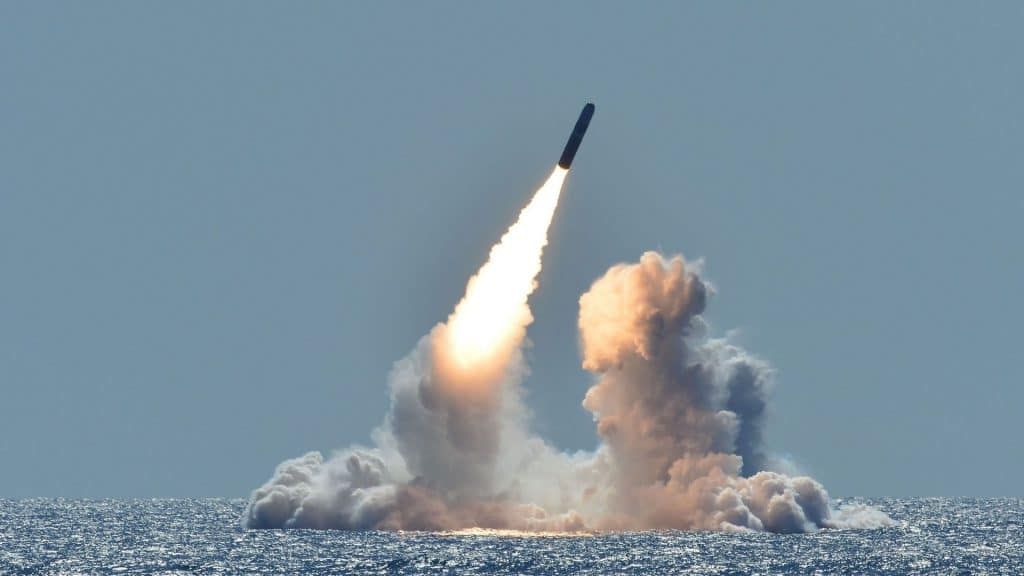Pandemic spending will force US defense budget cuts—some of which should come from nuclear weapons programs
By Lawrence J. Korb | May 8, 2020
 A Trident II D5 missile test. The US military, along with others around the world, is upgrading its nuclear weapons systems. Credit: US Navy/Mass Communication Specialist 1st Class Ronald Gutridge.
A Trident II D5 missile test. The US military, along with others around the world, is upgrading its nuclear weapons systems. Credit: US Navy/Mass Communication Specialist 1st Class Ronald Gutridge.
Even supporters of increased US defense budgets expect that, because the US government will likely spend trillions of dollars trying to rescue the economy from the effects of the COVID-19 pandemic, military spending in the United States is likely to decline significantly over the next couple of years. Those predicting such a decline include experts at the Stockholm International Peace Research Institute (SIPRI), the Center for Strategic and International Studies, (CSIS), American Enterprise Institute (AEI), the Center for Strategic and Budgetary Analysis, the RAND Corporation, and retired generals like David Barno and Hawk Carlisle.
According to SIPRI’s latest report, global defense spending has grown for five straight years and in 2019 amounted to almost $2 trillion. US defense spending has also grown significantly over this period. Since President Trump took office, the annual defense budget—which, at $740 billion, consumes more than half of federal discretionary spending—has increased by almost $100 billion compared to Obama’s last budget, and during the Trump presidency, total US defense spending has amounted to almost $3 trillion. As a result, the US alone now accounts for about 40 percent of the world’s total military expenditures and spends more than the next 10 highest defense spenders combined (seven of whom are our allies). In real terms—that is, taking inflation into account—the US defense budget is higher than it was during the Reagan military buildup or the wars in Korea and Vietnam.
In 2019, the combined budget of our two primary strategic competitors, Russia and China, was $326 billion—less than half of the Pentagon’s annual spending. Moreover, these countries will also likely have to reduce spending on defense to cope with the damage caused by COVID-19.
The primary reason that many experts foresee a drop in defense spending involves the massive US deficit. Since Trump came into office, the federal debt has grown by more than $3 trillion, and the deficit for 2020 was projected to reach $1 trillion, even before the pandemic. The Congressional Budget Office (CBO) had already predicted that the federal deficit would reach 98 percent of the United States’ total gross domestic product within a decade. The three stimulus packages already passed will increase the deficit for 2020 to almost $4 trillion.
But beyond the massive deficits, as retired Lt. Gen. David Barno and his colleague Nora Bensahel pointed out in a recent article in War On The Rocks, COVID-19 will also profoundly change the military’s role in defending the United States—something the Pentagon’s leaders apparently have not yet realized. Barno and Bensahel believe this will happen because many Americans will look at the immeasurable damage caused by the pandemic and correctly conclude that defending the homeland from catastrophic threats is more urgent than defending against foreign threats far from America’s shores. Barno and Bensahel offer specific areas—including personnel and some conventional programs like the F-35—that can and should be cut because of the vast cost of the pandemic. But they do not mention nuclear programs.
This omission is not surprising. Nuclear programs are often overlooked when it comes to budget reductions because many officials and analysts believe that those programs consume only a small part of the overall military budget. A closer analysis demonstrates that this is not the case.
In the proposed fiscal 2021 budget (which actually declines in real terms compared to fiscal 2020 and is now being considered by the House and Senate armed services committees), the Pentagon not only will spend significant amounts on nuclear programs but will increase that spending substantially. The 2021 budget proposal seeks to spend $29 billion—a $4 billion or 16 percent increase—on modernizing the weapons in its massive nuclear arsenal.
The National Nuclear Security Administration (NNSA), the part of the Energy Department that develops nuclear technology, wants to spend another $20 billion, which represents a $3 billion or 19 percent budget increase. If one adds in the $5 billion the government will spend on cleaning up nuclear sites and the $20 billion it proposes for missile defense, the cost of our nuclear programs climbs to approximately $75 billion. Some will argue that even this total amounts to a little more than 10 percent of the overall defense budget. And if one ignores environmental and missile defense costs and counts only the cost of NNSA weapons development and Defense Department delivery systems, that $50 billion amounts to only about 7 percent of the total budget.
But these claims underestimate the real impact of nuclear programs on the size of the defense budget. The nuclear programs include only the cost of developing and procuring nuclear weapons. They do not include support and operations for nuclear weapons and delivery systems like the Columbia Class ICBM submarine or the B-21 bomber.
To get a realistic handle on the cost of the nuclear program, it should be compared to the modernization (research and development and procurement) portion of the Defense Department budget. For fiscal 2021, Defense plans to spend about $244 billion on this area. Developing nuclear weapons amounts to 20 percent of the modernization portion of the budget, and total nuclear spending consumes about 30 percent. These percentages are not trivial, and neither is the absolute amount being spent.
Even the low-end calculation of nuclear spending—$50 billion—is more than we spend on the entire State Department, or on ship building, or on aircraft or tank procurement. In fact, to increase the NNSA budget this year, the Pentagon had to cancel a nuclear-powered attack submarine over the objections of the Office of Management and Budget. And nuclear spending is projected to rise.
Over the next five years, the Pentagon plans to spend increasing amounts on modernizing nuclear weapons and nuclear technology. If no changes are made, these two items will consume at least $170 billion between fiscal 2021 and fiscal 2025 on just the Defense Department portion of the modernization budget, and they will draw another $100 billion the NNSA budget.
To reduce spending on nuclear weapons safely over the next decade, the United States needs to do two things:
First, take up Russian President Vladimir Putin’s offer to extend New START, which can be done without Senate approval, and begin negotiations to reduce the deployed nuclear weapons on both sides to no more than 1,000 from their current level of 1,550. This will allow us to cancel the land-based portion of our nuclear modernization program and the Long Range Standoff Weapon (LRSO). Stopping these programs will save $2 billion in fiscal 2021and at least $100 billion over the next five years.
Second, the Trump administration needs to begin talks with the Russians aimed at resolving our differences over the Intermediate-Range Nuclear Forces Treaty (INF). The Trump administration announced it would pull out of the treaty in October 2018 because it argued that the Russians were testing missiles that violated the treaty’s terms; the US exit became final in the summer of 2019. The Russians, for their part, argued that the missile defense systems the United States has deployed in Poland and Romania could be retrofitted to launch intermediate range missiles, also in violation of the treaty. If talks on somehow reinvigorating the INF are begun, the United States could halt its programs to deploy intermediate range missiles on Navy ships and submarines. Spending on nuclear warheads in fiscal 2021 is projected to be more than $2 billion. Not only is this a waste of money; it also increases the likelihood of nuclear war.
Since the Russian defense budget will also have to decrease as a result of the COVID-19 pandemic, Moscow should be open to discussions that lead to reduced nuclear costs. The Chinese also will find it difficult to keep increasing their defense budget at the pace they have maintained over the past decade. Therefore, they should be willing to join talks, particularly on intermediate-range weapons.
The pandemic has had and will continue to have a disastrous impact on the global community. But, if the United States uses this health and economic disaster as an opportunity to take the lead in limiting the danger of nuclear weapons, some good may come of it. As bad as this pandemic is, a nuclear war would be much worse.
Together, we make the world safer.
The Bulletin elevates expert voices above the noise. But as an independent nonprofit organization, our operations depend on the support of readers like you. Help us continue to deliver quality journalism that holds leaders accountable. Your support of our work at any level is important. In return, we promise our coverage will be understandable, influential, vigilant, solution-oriented, and fair-minded. Together we can make a difference.
Keywords: Coronavirus, Defense Department, INF, LRSO, NNSA, New START, nuclear budget reduction
Topics: Analysis, Nuclear Weapons















